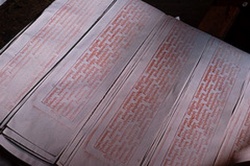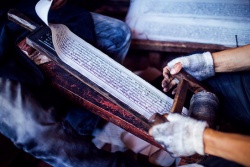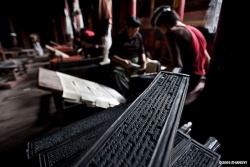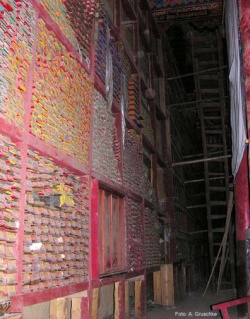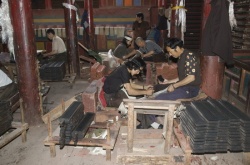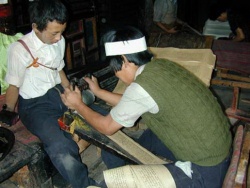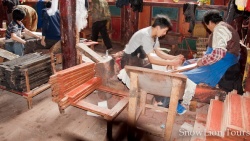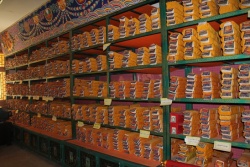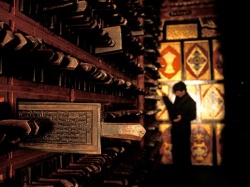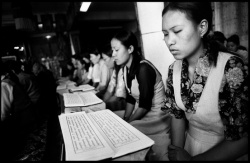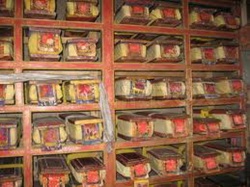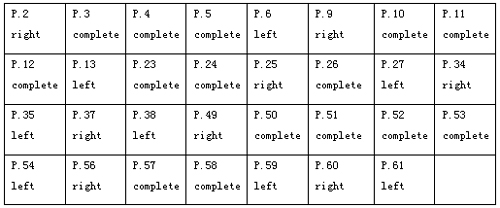A study of the Earliest Tibetan Woodcut Copies
The art of printing, one of the four great inventions of China, occupies a prominent position in the history of the science and technology of China. In the Sui and Tang Dynasties, woodblock printing was invented due to a rapid development in culture, a long-established use of a paper and ink and seal and stone carving. Great numbers of historical manuscripts and early examples of printed matter unearthed in succession have confirmed this great invention. The invention of the art of printing is not only an innovation in copying a great number of scripts, but also a profound revolution in the transmition of literature. The art of printing was popularized, accelerating the spread, inheritance and development of culture, which in turn greatly promoted civilization and progress.
During the period from the Tang to the Song Dynasties, woodblock printing flourished and reached a high level of development. Furthermore, its application became more popular in the Song Dynasty many ethnic scripts were created by Liao (founded by Khitan), Xixia (set up by Dangxiang), Kin (established by Urchen) and Uighur. In these regions, under the influence of the Song Dynasty, woodblock printing was applied and developed.
Tibetan nationality has a long history and a splendid culture, which has made great contribution to the development of Chinese civilization. In the early Tang Dynasty, the interchanges between Tibet and the Central Plain became closer and more frequent. Due to their own development, Tibetans expanded their territory to the north and the east. They gradually reached the Hexi Corridor (Gunsu) and even the Great Bend of the Huanghe (Yellow) River. They had close contacts with Han, Dangxiang and Uighur people and had profound and extensive interchanges with them in culture, science and technology. In China’s medieval period, most great influential ethnic groups believed in Buddhism. As a result, Tibetan religious and cultural influence increased. At that time, most Tibetans also believed in Buddhism and monasteries had very strict rules regarding the study of Buddhist scriptures by monks. Therefore, Buddhist scriptures were in great demand. Although it was regarded as meritorious and virtuous for Buddhist believers to hand-copy Buddhist scriptures, the output was less than expected. From the Song Dynasty on, woodblock printing developed rapidly and, owing to the development of Tibetan religion and culture, block-printed Sutras were in high demand. Woodblock printing thus became a mature art form in Tibet. However, no definite records exist in manuscripts to show that Tibetans began to use block printing in the Song Dynasty, and early Tibetan woodcut copies (earlier than the Ming Dynasty) have not yet been found. So, making a study of early Tibetan woodblock ptinting and doing research on early Tibetan woodcut prints is always an important topic in Tibetology and in the history of science and technology (history of printing included).
Tibetan culture has its own languages, and Tibetan script was created early in the 7th century. According to Tibetan historical books, Thon-mi-sam-bho-ta, a famous Tibetan scholar, created Tibetan script in the 7th century based on the Sanskrit writing system. Since then, Tibetan script has been revised and standardized for three times. As Tibetan script was very practical, large numbers of Tibetan manuscripts were written with his script. Consequently there now exists a great variety of early Tibetan manuscripts written with this script during the period from the 7th to the 8th century. When did Tibetans begin to use woodblock printing? The descriptions differ in works written by later generations. For example,〝Buddhism was advocated in the Tubo Kingdom, where centres for translation work were specially established. In the Song Dynasty, block-printed Sutras were introduced from the Central Plain. There were as many books in Tibetan as in Han.〞[1] Another example: 〝After the 13th century, the woodblock printing technique was introduce and Buddhist versions were printed in large scale. 〞[2] However all these descriptions of documents do not mention their provenances and idiographic contents. Recently, some sources have mentioned the former residence of Thon-mi-sam-bho-ta, scholar and creator of Tibetan script. The making methods of Tibetan joss sticks, Tibetan paper (which is said to be created by him) and woodblock printing technique are skill kept at Tunba village in Tunba Town, Nimu County of the Tibet Autonomous Region. Most farmhouses still keep small workshops used to make Tibetan paper and woodcut block. According to this legend, Tibetan woodblock printing appeared in the early-Tang Dynasty. Of course, this is only a legend among the locals.
As for the begining of Tibetan woodblock printing, the earliest records believe that it is in the early 14th century. A monk named Luguan Zhuba printed more than thirty copies of Prajna White Parasol Sutras (in Tibetan) and over ten Sutras and Tantras in the 6th year of Dade period in the Yuan Dynasty (1302), then sent them to Tibetan and other places for chanting.[3] This is the earliest record of Tibetan block printing in the Yuan Dynasty. However, this printed matter was not preserved. Hu Jiangzu, a Han monk (nPhages-pa's disciple), translated Tubo Chronicles of the New History of Thang Dynasty into Tibetan. Under the supervision of Rin-chen-sbrag, Grand State Tubor, it was block-printed in Lintao in the second year of the Taiding period (1325). Unfortunately, the printed copies were not preserved either[4].
The publication of Tripitaka-bKav-vgyur (Yongle edition) in the Ming Dynasty is generally thought of as the origin of Tibetan woodblock printing Tripitaka. In the 8th year of the Yongle period in the Ming Dynasty (1410), based on Tshal-pa bKav-vgyur, Tripitaka the Yongle edition was printed in Tibetan, in Nanjing. Altogether 108 sets were printed in red. Then they were enshrined and worshipped at Wutai Mountain and presented to eminent monks of Sa-kya-pa Sect, Kar-ma bKav-btgyud-pa Sect, Tsong-kha-pa and others living in Tibetan-inhabited regions. Nowadays, two copies are left: one in the Potala Palace and the other in Se-ra Monastery.[5] They are the earliest Tibetan block-printed Tripitaka. Printing Triptaka effectively promoted the development of printing in Tibetan-inhabited regions and exerted a far-reaching influence on later Tibetan woodblock printing. Thereafter, scripture printing houses sprang up in many regions.
As mentioned above, there were neither definite records about publishing Tibetan manuscripts in the Song Dynasty, nor was there any Tibetan printed matter earlier than the Ming Dynasty. In order to study early Tibetan woodblock printing and do some research on earlier Tibetan printing, we should find a new day; we should begin with Xixia, adjacent neighbor of Tibet.
In the Song Dynasty, Xixia was an influential and important dynasty during the medieval period of China. The majority of its people were Dangxiang and kept close contact with Tibetan when they moved towards the north in the late-Tang Dynasty. Xixia, with a history of 190 years, had ten lords, a vast and stable territory and well-formulated institutions and laws. Xixia was prosperous, a powerful military force and rich in culture and education. It maneuvered between various political grouping (Song, Liao, Kin, Tubo and Uighur). It played a very important role in history. At first, it was in a tripartite balance of forces with the Northern Song and Liao, who later confronted each other together with the Southern Song and Kin.
Having occupied the Hexi Corridor (Gansu) Xixia had more and direct interchanges with Tubo. Parts of Tibetan regions were under the jurisdiction of Xixia neighbor of Tubo. Within its territory, there lived Tibetan, Han and Uighur people.
Xixia had a developed culture and created scripts to record Dangxiang languages (Fanwen, later named Xixia Script). This script was widely accepted as standard and this was later enforced by order. Many manuscripts were recorded with this script. People, from the highest-ranking governors to the commonplace, all believed in Buddhism. Xixia accepted not only Chinese Buddhism, but also Tibetan Buddhism. Many Tibetan monks preached Buddhism in Xixia. At that time, numerous Tibetan Sutras were translated into Xixia script, many Tibetan Buddhist paintings (Thangkas) were completed and large numbers of Tibetan-style Stupas and monasteries were set up.[6]
Noticeably, the Xixai Dynasty initiated the system of conferring the titles of Grand State Tutor upon Tibetan monks. So far, we have found the names of five Grand State Tutors (all of them are Tibetan monks) in Xixia manuscripts. As a unique Buddhist system in the feudal society of China, the system of Grand State Tutor first appeared in the Xixia Dynasty with Dangxiang people as its main recipients. The Yuan Dynasty (controlled by the Mongols) aslo inherited this system them perfected it.[7] The system of Grand State Tutor in the Xixia Dynasty showed that Tibetan Buddhism had far-reaching influence on Xixia. Besides, Xixia and Tibet had a close cultural relationship.
Xixia learned block-printing technique from Han people, and had a developed block-printing technique. Extant Xixia manuscripts have many woodcut copies (including those with Xixia script and in Han). Moreover, a movable type was also developed in Xixia. Uighurs, who was Buddhist at that time, block-printed Sutras in Uighur script, and also applied and developed this movable type. With the spread of Buddhism, publishing Buddhist scriptures became the major task of publication in Xixia, which, in return, promoted the greater prosperity of publication.
Xixia's advanced printing technique closely influenced Tibetans, who created conditions for Tibetan block printing and publication in Xixia. So, woodblock printing Tibetan manuscripts in Xixia was very natural development.
While collecting materials concerning Halahot manuscripts preserved in Russia, scholars have found some new and important manuscripts, which are thought of as a new breakthrough for the studies of this issue. In 1909, a Russian expedition, headed by Zlof, found many rare and precious historical materials (including manuscripts and cultural relics) in the ruins of Halahot of China, and carried them to St. Perterburg. Among them, manuscripts with Xixia script and the great majority were in Han, while only a small part was in Tibetan. In 1993, The Nationality Institute of the Chinese Academy of Social Science and the St. Petersburg Branch of the Institute of Oriental Studies of the Russian Academy of Science signed an agreement so as to arrange, edit and publish those manuscripts preserved in Russia (in Han, Xixia and other ethnic scripts). Since 1993, the Chinese side have successively sent four groups to St. Petersburg to arrange, record and screen Xixia manuscripts preserved in Russia, and have published eleven volumes of the Halahot manuscripts preserved in Russia.[8]. More than three volumes of manuscripts concerning common customs, and over ten volumes of Buddhist manuscripts with script and one volume on minority nationalities (including Tibetan manuscripts ) will be published in the future.
Some Russian experts have arranged, recorded and published Halahot manuscripts in Xixia and Han script. However, these manuscript have never been recorded and published in a systematic way. In 1993, we visited the St. Petersburg Branch of the Institute of Oriental Studies of the Russia Academy of Science, hoping to arrange and record them. Since then, we have contacted the Russia side several time, telling them of our hope to examine, arrange and screen some manuscripts with ethnic scripts (including Tibetan manuscripts). Unfortunately, we have not succeeded. We have only screened several Tibetan copies. In 2000, we went to Russia for the fourth time to screen manuscripts. With the help of some Russia experts, we read some Tibetan manuscripts (60 codes, about 300 pages[9], including some Buddhist materials and non-religious manuscripts).
Most of Halahot manuscripts preserved in Russia were found in an earthen tower outside the city, and manuscripts written in the Xixia Dynasty or earlier to it were also kept there. The manuscripts found in other areas of this city were written both in the Xixia Dynasty and in the Yuan Dynasty. Mr Huang Mingxin from the National Library of China checked them and proved that some Halahot manuscripts were characteristic of ancient Tibetan script. For example, there was a letter "?" and a subscript "ya" (not omitted). On the back of the manuscript, you can find that most of these Tibetan manuscripts have such characters, for example in manuscripts Code XT-1, 2, 11, 15, 16, 17, etc. Also on the back of other manuscripts, there are some Xixia scripts, which is a proof of the early Tibetan manuscript (such as code XT-63). Most of these Tibetan manuscripts were written in the Xixia Dynasty.
In addition to the early manuscripts from the Dunhuang Grottoes, very few Tibetan written in the Tang-Song Dynasties were left. The discovery of the early Halahot Tibetan manuscripts not only increased the number of the early Tibetan manuscripts, but also added much important contents to them and provided new material for research on the history of Tibet and Tibetan culture.
When we began to arrange these precious manuscripts, we were astonished to find large numbers of Tibetan copies among them, such as Codes XT-21,22,23,40,41,63,65,67,68,69. Among them, Codes XT-40, 63, 65, 67, 68, 69 were block-printed manuscripts and Code XT-21, 22, 23, 41 were wood-carved pictures with wheel designs.
In fact, the book Lost Kingdom on the Silk Road (published in 1996) mentioned three catalogues of Tibetan block-printed copies: two involve pictures with wheel designs, and one is a Buddhist scripture. This book described their shapes, contents and dates, and I believed that they were wooden printed matter during the period from the late-12th century to the early 13 century.[10] Their publication gave us the chance to read the early Tibetan block-printed copies. However, they were only individual manuscripts as the main subject. This book did not offer more introduction, analysis and discussion about their value and historic significance in the history of printing and Tibetan culture.
The Tibetan block-printed copies of Halahot manuscripts preserved in Russia are different in binding form: 1、Sanskrit binding (widely used in Tibetan manuscripts); 2、butterfly binding 3、individual pages with wheel designs (borrowed from the Gentral Plain or Xixia Dynasty).
Originating from Indian palm leaf Sutras, Sanskrit binding was adopted by Tibetans. Named as "long-striped book" by Tibetan, it is made up of many pieces of long-striped paper in the same size. Halahot Tibetan block-printed manuscripts (Sanskrit binding) include Code XT-41,69 and Code XT-40 (Cover-incomplete page of Prajan Sutra; right page-incomplete page of Prajina Sutra; right page-incomplete; 10.6cm. high, 28.1cm. wide; some Sutra words on the central part of one side; cloud design on the top and lotus petals on the bottom; lotus flowers on the left face of the page; an image of Buddha on the left face of its back, and six lines of Buddhist scriptures on the right face; four columns between the image of Buddha and scriptures).
As the earliest form of bookbinding, butterfly binding appeared in the Song Dynasty. Paper sheets (with words) were neatly folded in half along the spine. Paste would then be applied to the folded edges of paper sheets, and the folded sheets would be stacked together so that the folded edges may form the spine of book. Butterfly-bound books were more convenient than scrolled books to read. Prevailing in the Song and Yuan Dynasties, butterfly binding was a very important development of bookbinding. After introduced, it was rapidly accepted. According to the extant Xixia manuscripts, butterfly binding was one of the basic binding forms popular at that time. Now, there exist great numbers of handwritten and woodcut copies in butterfly binding, especially block-printed non-religious manuscripts.
Halathot Tibetan block-printed and butterfly-bound manuscripts include Codes XT-63, 67, 68. Both front and back covers of Codes XT-67 are incomplete. According to its content, it probably included great varieties of Tibetan Buddhist rituals. On Page 19, there is a Sutra entitled "Dingji Zunsheng Fomu Tuoluoni Gonged Yijing Shelue". On Page 20, there is a record of Zaye Ananda (an Indian monk, studying "Five kinds of Knowledge") and names of Tubo monk-translators. Zaye Ananda (formerly an Indian wonk) translated Sutras and did missionary work in Xixia. Xixia Royal House conferred upon him the title of "Grand State Tutor of Five Kinds of Knowledge" and an official title (anyone who had this official title could be invested as prime minister). He once preached some important Sutras, as Dingzun Shengguan Zizai Dabei Xingongshun.[11] According to the topics of the above-mentioned block-printed manuscripts, these Sutras were also translated into Tibetan. In these Sutras, the ancient Tibetan letter〝?〞appears repetitiously, which proves that the earliest Tibetan block-printed manuscripts (in ancient Tibetan in Xixia Dynasty) are of important value in literature as well as cultural relics. Every paper of these Sutras (with right and left faces and six lines on each face) is 13cm. high and 17.5cm. wide. Its frame is 9.4cm. high and 15.8 cm. wide. Some pages remain intact, but some right, left or 〝complete〞pages are missing. The pages kept are recorded as follows:
Altogether 31 pages survive, among which, 15 pages are completed and 16 pages only have one face, i.e. totaling 46 faces. Since one page has two faces and a double face printing technique is used, in fact one page has 4 faces (with words). For example, the right face of P.2, P.3 and the left face of P.4, 9.5 and the left face of P.6 make up of one page, and so on. Between two faces, there is one page of type with Chinese page numbers. As butterfly-bound Sutras are easy to lose, they are stitched later.[12]
Tibetan Butterfly binding changed the vertical writing form of Han and Xixia script (writing from right to left, and from top to bottom; first writing on the right face and them writing on the left face) and created the transverse writing form of butterfly binding to adapt itself to the Tibetan butterfly-bound Sutras, lines are written from the top to bottom, and from the left to right. More especially, on a page of type, every line goes right across both faces, i.e. you can read through the same line on two faces of one page. It is a flexible application of butterfly binding on transverse writing with ethnic scripts, and is also a new development of butterfly binding. The Song Dynasty is the golden age of butterfly-bound manuscripts; accordingly, all the extant butterfly-bound books (Song edition) are the apotheoses of ancient manuscripts. However, most of them have been changed into stitched binding by later generations, so it is difficult to see the original appearance of Song edition butterfly binding at the time. To our surprise, among the ancient manuscripts (with Xixia and Tibetan script during the corresponding period in the Song Dynasty) discovered by modern archaeologists, there are so many block-printed manuscripts of original butterfly binding. They are very precious and of special value as editions. Butterfly binding is an early form of the decorative art of book binding which, from the aspect of decoration, prove the early emergence of Tibetan block-printed manuscripts.
In Halahot Tibetan manuscripts, there are four kinds of individual pictures with wheel designs. For example, Code XT-21 is a tortoise-shaped picture with wheel designs (web of paper: 24×24.5cm., picture canvas: 18.7×21 cm). In the centre of this picture is an image of a land tortoise above which there are seven concentric circles (diameter of outer circle: 14.7 cm. diameter of inner one: 3.7 cm.). On the circumferences of four bigger circles there are incantations in Tibetan and Sanskrit used to pray to ward off calamities and send down blessings. In the inner circle there is a picture of nine palaces. Outside with there are, in successive circle, Eight Diagrams, Zodiac, Tibetan incantations (three circles), and turtle veins. Out of the outermost circle, there are head (top), cauda (bottom) and feet (foursquare). Another example, Code XT-23 is an open pigskin-shaped picture with wheel designs (web of paper: 24.5× 19.5cm., picture canvas: 15×19.5 cm., top right corner: incomplete). In the center of the pigskin, there is a big circle with a square in it whose four directions. In the square, there is a small circle on which Tibetan Buddhist scriptures were written. Between the single line and the double line of the big circle, there is a line of Tibetan script, which is incantations for killing evil forces, and getting rid of diseases and disasters.[13] Until today, similar pictures with wheel designs are woodblock-printed in the Gerge Scripture Printery.[14]
Butterfly-bound Sutras are woodblock-printed masterpieces: neatly written, elegant script, carefully carved, tidy rows and using the broad space of the whole page. Complicated animal as well as square or round patterns are carved in the pictures with wheel designs. Moreover, the scripts of the pictures are clear and fluent. Most especially, the carving of Tibetan scripts in the circumferences has reached a high degree of complexity, although it is more difficult. The skillfulness and fineness of printing show that these manuscripts are mature examples of the art of printing. Thus it can be estimated that Tibetan woodblock printing had already existed for a long period by then. We can extrapolate that Tibetan woodblock printed matter existed before the 12th -13th century. Although these Tibetan woodblock-printed manuscripts were discovered in the ruins of Xixia, they reflected Tibetan culture then and there. More importantly, they reveal Tibetan printed matter from the 12th -13th century (two centuries earliest than Tibetan Tripitaka of Yongle edition) and are characteristic of early Tibetan printing and publishing. So it can be seen that Tibetan also used woodblock printed technique in the earlier period that was reflected in Xixia and Han nationalities very well. In addition, as a characteristic creation of Tibetan culture in the Xixia Dynasty, the application of butterfly binding in Tibetan manuscripts (with transverse writing) possesses unique features in the history of printing and publishing in China.
From 1988 to 1995, the Research Institute of Dunhuang had explored the rock cave in the northern district of Dunhuang Grottoes five times, and found a large number of literary and historical relics, including manuscripts in Han and Tibetan, with Xixia, Uighur, and Syrian scripts. Among to the Tibetan manuscripts, there were incomplete parts: there were found in the 59th cave in the northern district (with code B59: 9-1-3). After studying, experts confirmed that they were printed in the Yuan Dynasty, and 〝According to the Han-Tibetan woodblock printed history, they reached Dunhuang from the hinterland〞[15] Probably, the author thought that there was no woodblock printing in Dunhuang or in the northwestern areas at that time, so he regarded them as manuscripts reaching Dunhuang from Hinterland. Actually, the woodblock printing was widely used in this area at that time. So whether or not they reached Dunhuang form the hinterland is worth further discussion.
In the Xixia Dyansty, cultural interchanges, influences and amalgamation among Dangxiang, Han and Tibetan nationalities were in multiple directions. For example, when butterfly binding appeared in Tibetan manuscripts, Sanskrit binding also appeared in Xixia manuscripts.
Generally speaking, Sanskrit binding is more adaptable to transverse writing (writing across pages from left to right and from top to bottom). As Xixia manuscripts use the vertical writing form, their Sanskrit binding also runs vertically from top to bottom and sets up lines from right to left. There are two kinds of situations: 1、complete the first face, then spin to top, and then continue writing on the back; 2、complete the first face, then spin to right, and then continue writing on the back. Nowadays, we can only see such forms of decoration in Tibetan manuscripts stored in the Russian library. The decorative form changes the long-striped book type (for writing alphabetic words) into vertical writing form (for writing Chinese characters). It was created by Xixia people on the basis of Tibetan culture, which demonstrates not only the cross-national cultural communications at that time, but also the spread and development of science and technology across clan borders.
Footnotes
- ↑ Encyclopdia of China. Nationality volume. Beijing: Encyclopedia of China Publishing House, 1986: Page 530.
- ↑ Editing Group of Tibetan Brief History, Brief History of Tibet. Lhasa: Tibet People Publishing House, 1985: Page 5.
- ↑ Wang Guowei, Early Editions of Printed Books in the Fiangsu-Zhejiang Areas. 1992.
- ↑ See History of Tibet. Volume 4. from Tibetan Hot line.
- ↑ Some Tibetan manuscripts are recorded as cuprum block-printed publication.
- ↑ Shi Jinbo, Tibetan Buddhism in Xixia. China Tibetology. 2002, Vol.1.
- ↑ Shi Jinbo, A Brief History of Xixia Buddhism. Yinchuan: Ningxia People Publishing House. 1988.
- ↑ Shi Jinbo, Wei Tongxian, Kqanov, Halahot Tibetan Manuscripts Preserved in Russia. Shanghai: Shanghai Chinese Classics Publishing House. Vol.1-11, 1996-2000
- ↑ The author has asked Mr Huang Mingxin from National Library of China about some clearer Halahot Tibetan manuscripts. After identifying them, Mr. Huang translated, explained and name parts of manuscripts. The author is grateful forhis kind and warm assistance.
- ↑ The State Hermitage Museum. Lost Kingdom on the Silk Road (Chinese edition, Taiwan) 1996: Page 274-278.
- ↑ Shi Jinbo, Tibetan Buddhism in Xixia, China’s Tibetology. 2002, Vol.1. Textually researched by Dr. Chen Weirong, Tibetan manuscript (Code TK164-165), i.e. Tibetan versions of Shengguan Ziai Dabei Zongchi Gongneng Yijinglu and Shengxiang Dingzun Zongchi Gongneng Yijinglu. See Halahot Tibetan Manuscripts Preserved in Russia (Shi Jinbo, Vol.4. Shanghai Chinese Classics Publishing House. 1997).
- ↑ Halahot Tibetan Manuscripts Preserved in Russia. XT-67.
- ↑ Halahot Tibetan Manuscripts Preserved in Russia. Xt-21°23
- ↑ Edited by Sichuan Nationality Publishing House. The Gege Classics-Printing Institute. Chengdu: Sichuan Nationality Publishing House. 1981.
- ↑ Huang Hao, a Translation, Explanation and Study of Tibetan Manuscripts, Discovered in the Rock Cave in the Northern District of Dunhuang Grottoes (1).Rock Cave in the Northern District of Dunhuang Grottoes. Vol.1. Beijing: Culture Relics Publishing House. 2000.
Source
From China Tibetology (Chinese Edition) No.4, 2005
Translated by Zhang Xiaomei.
zt.tibet.cn
